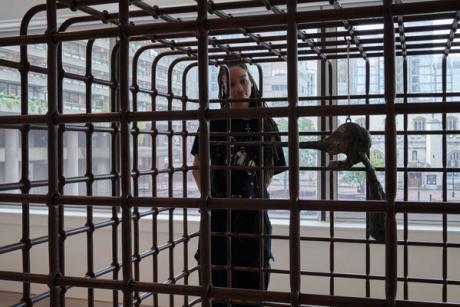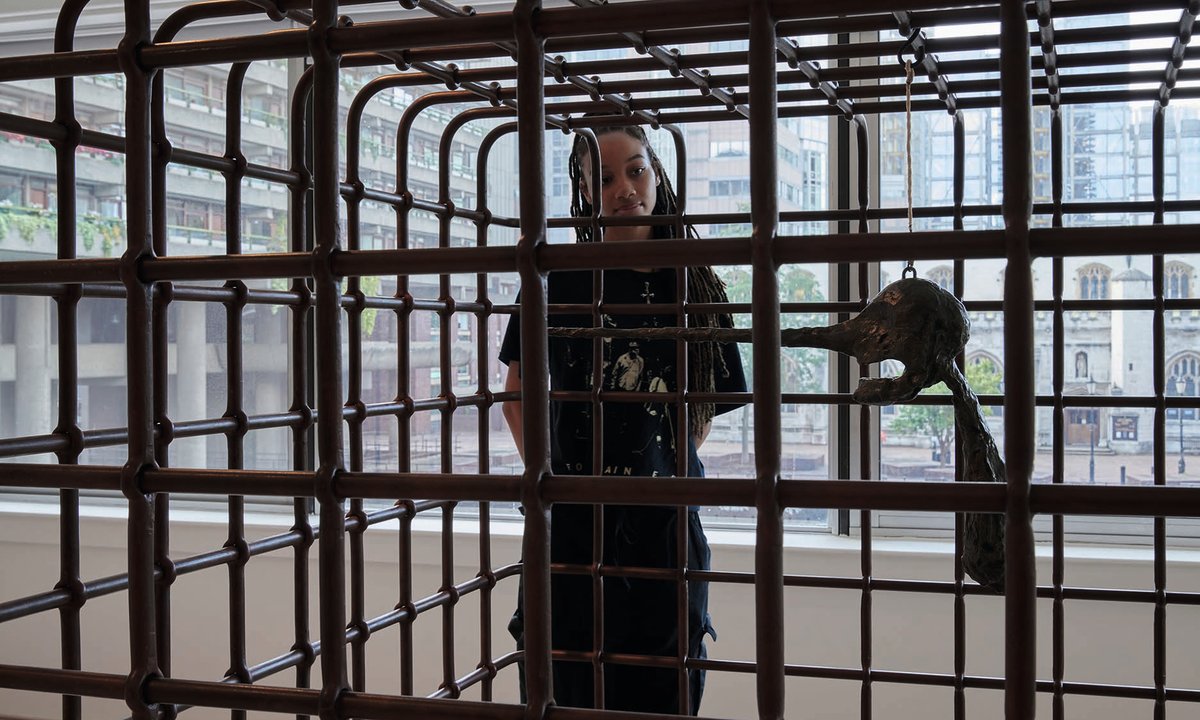
A revelation of the yr to this point in London has been the brand new area for artwork on the Barbican. A former restaurant there was redesigned and has hosted two of 2025’s finest exhibits, through which the up to date artists Huma Bhabha and Mona Hatoum have been proven alongside Alberto Giacometti.
I’ve written earlier than about how inventive languages separated by a long time or centuries can have an alienating impact on one another if proven collectively with out subtlety. However these exhibits are completely judged and paced. In fact, it’s partly about the suitable selection of artists: Bhabha’s and Hatoum’s work engages with Giacometti’s in kind or topic, and generally each. However a part of the enjoyment of those exhibits—curated by the Barbican’s Shanay Jhaveri alongside Émilie Bouvard, the director of collections and scientific programme on the Fondation Giacometti—is in the way in which that affinities and distinctions are equally welcome.
The superb exhibition information for the Giacometti-Hatoum present notes that each artists are “preoccupied with the human physique in its vulnerability and resilience” however factors out that Hatoum by no means straight explores figuration, Giacometti’s final obsession. In formal phrases, Giacometti largely constructed his sculptures up from nothing to one thing, whereas Hatoum usually takes the discovered object and manipulates it.
However comparisons should not pressured. The lightness of the associations is exemplified in the way in which that the type of Giacometti’s Figurine Between Two Homes (1950), a strolling determine in a vitrine between two packing containers, is gently echoed within the movie of Hatoum’s efficiency Roadworks (1985), through which she walked barefoot, dragging her Dr Martens boots behind her by their laces: she is “contained” like Giacometti’s determine, however in a monitor exhibiting the video.
Carrying emotional drive
Most vital is that Giacometti’s work isn’t ossified. He seems like a dwelling artist. Bhabha and Hatoum have been introduced nearly as collaborators. Within the Hatoum present, Giacometti’s sinister head with a vastly prolonged nostril, Le Nez (1947), is contained inside Hatoum’s cage, Dice (2006), shaped from metal bars whose shapes relate to the metallic grids protecting medieval home windows. It solely emphasises the primal and visceral influence of Giacometti’s tortured visage. Elsewhere, his Girl with Her Throat Minimize (1932)—one in every of his early sculptural compositions laden with Surrealist intercourse and violence—is in sight of Incommunicado (1993), Hatoum’s youngster’s cot whose springs have been changed with cheese wire, turning it right into a home killing machine.
Bhabha and Hatoum have been introduced nearly as Giacometti’s collaborators
However whereas filled with aesthetic and lyrical dialog and play, each exhibitions carry an emotional and political drive. When he made them, Giacometti’s post-war sculptures appeared aptly to replicate the anxieties and fragility of people in a world reeling from the horrors of the Holocaust. Each Bhabha and Hatoum have created photos that talk to newer international inhumanities. Hatoum has made quite a few works reflecting on her expertise as a girl born in Beirut to Palestinian mother and father.
I noticed the Giacometti-Hatoum present the day after the Worldwide Affiliation of Genocide Students handed a decision stating that Israel’s conduct in Gaza meets the authorized definition of genocide, as specified by the UN conference. Again and again, photos of Gaza at present echo Hatoum’s work, from Stays of the Day (2016-18), a home area apparently decimated after a cataclysmic occasion, to Inside Panorama (2008), a naked mattress with barbed wire springs and a pillow into which the historic map of Palestine has been embroidered in human hair.
Subsequent to those works, Giacometti’s figures, with their “extraordinary however apparently perishable grace”, as Jean-Paul Sartre put it, appear as if made yesterday; everlasting emblems for humanity amid a brutal world.
• Mona Hatoum, Encounters: Giacometti, the Barbican, London, till 11 January 2026

